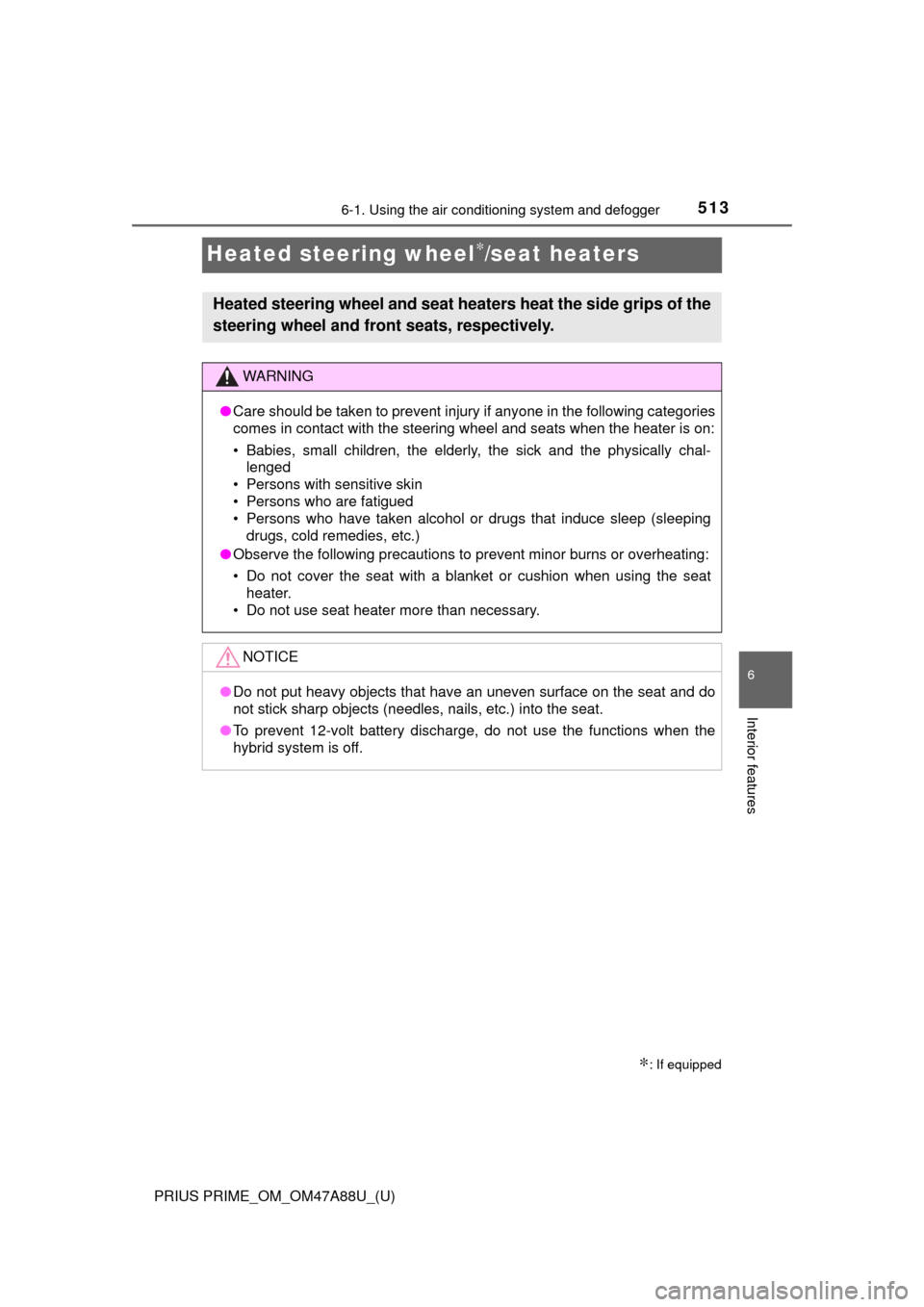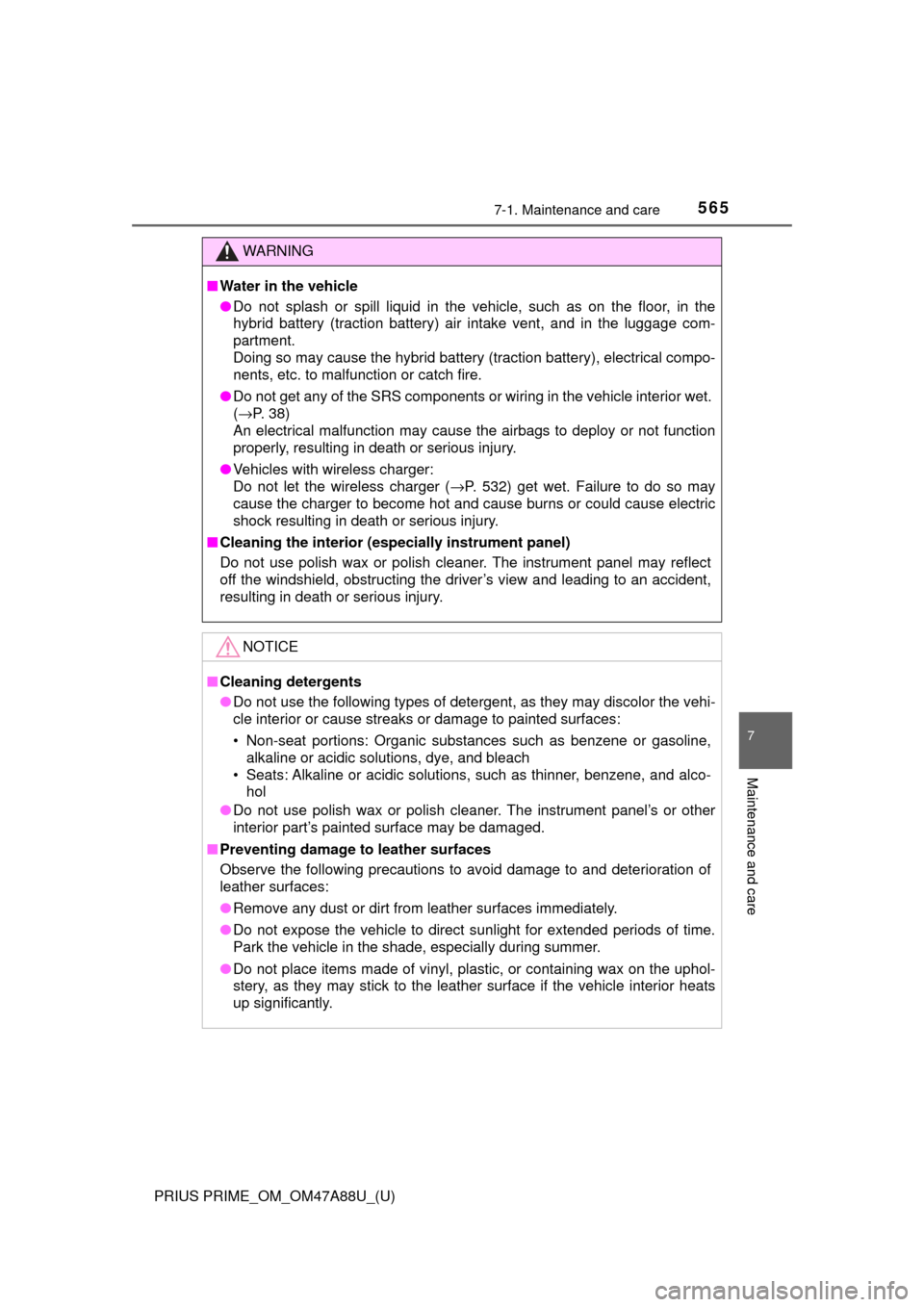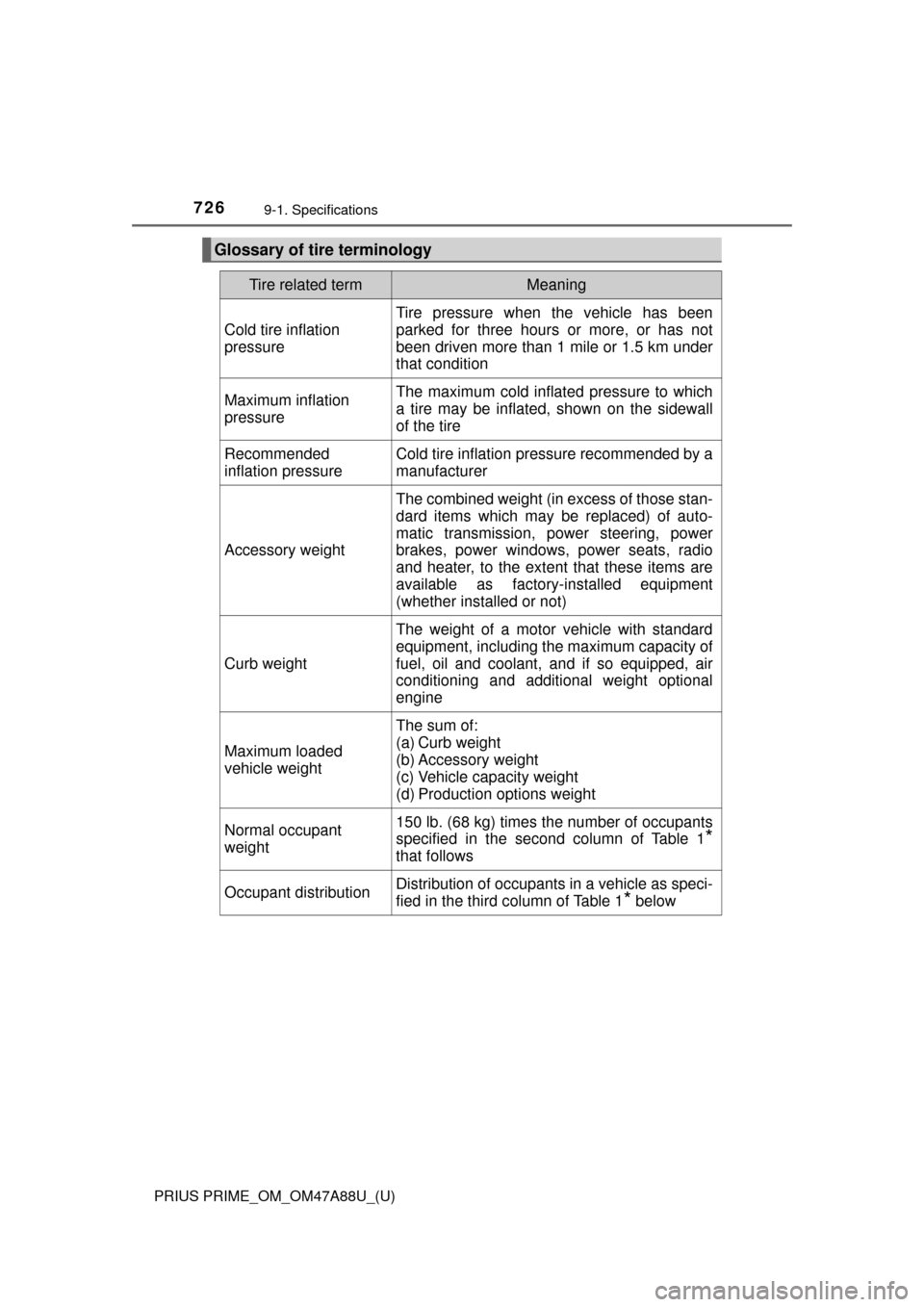2017 TOYOTA PRIUS PRIME seats
[x] Cancel search: seatsPage 320 of 784

320
PRIUS PRIME_OM_OM47A88U_(U)
5-1. Before driving
WARNING
■Things that must not be carried in the luggage compartment
The following things may cause a fire if loaded in the luggage compart-
ment:
●Receptacles containing gasoline
●Aerosol cans
■Storage precautions
Observe the following precautions.
Failure to do so may prevent the pedals from being depressed properly,
may block the driver’s vision, or may result in items hitting the driver or
passengers, possibly causing an accident.
●Stow cargo and luggage in the luggage compartment whenever possi-
ble.
●Do not stack cargo and luggage in the luggage compartment higher
than the seatbacks.
●When you fold down the rear seats, long items should not be placed
directly behind the front seats.
●Never allow anyone to ride in the luggage compartment. It is not
designed for passengers. They should ride in their seats with their seat
belts properly fastened.
●Do not place cargo or luggage in or on the following locations.
• At the feet of the driver
• On the front passenger or rear seats (when stacking items)
• On the luggage cover
• On the instrument panel
• On the dashboard
●Secure all items in the occupant compartment.
■Capacity and distribution
●Do not exceed the maximum axle weight rating or the total vehicle
weight rating.
●Even if the total load of occupant’s weight and the cargo load is less
than the total load capacity, do not apply the load unevenly. Improper
loading may cause deterioration of steering or braking control which
may cause death or serious injury.
Page 489 of 784

PRIUS PRIME_OM_OM47A88U_(U)
4896-1. Using the air conditioning system and defogger
6
Interior features
■Change the airflow mode
Move the airflow change knob
upwards or downwards to
change the airflow mode.
The air outlets used are
switched each time the knob is
operated.
Air flows to the upper body
Air flows to the upper body
and feet
Air flows to the feet
Air flows to the feet and the
windshield defogger oper-
ates
■S-FLOW mode
In S-FLOW mode, priority for the ai rflow is given to the front seats,
reducing the airflow and air conditio ning effect on the rear seats.
If a passenger is not detected in the front passenger seat, priority
for the airflow will be given to the driver’s seat only.
However, air will always be blown from the side outlet of the front pas-
senger seat.
S-FLOW mode will be activated autom atically according to the set
temperature, outside temperature, etc. ( →P. 494)
The S-FLOW mode can be turned on/off manually by pressing .
The indicator illuminates when in S-FLOW mode.
■
Other functions
● Switching between outside ai r and recirculated air modes
( → P. 490)
● Defogging the windshield ( →P. 491)
● Defogging the rear window and outside rear view mirrors
(→ P. 491)
Airflow change
knob
1
2
3
4
Page 500 of 784

5006-1. Using the air conditioning system and defogger
PRIUS PRIME_OM_OM47A88U_(U)■
S-FLOW mode
In S-FLOW mode, priority for the ai
rflow is given to the front seats,
reducing the airflow and air conditio ning effect on the rear seats.
If a passenger is not detected in the front passenger seat, priority
for the airflow will be given to the driver’s seat only.
However, air will always be blown from the side outlet of the front pas-
senger seat.
S-FLOW mode will be activated autom atically according to the set
temperature, outside temperature, etc. ( →P. 505)
The S-FLOW mode can be turned on/off manually by selecting on
the air conditioning control screen.
The indicator illuminates when in S-FLOW mode.
■
Other functions
● Switching between outside ai r and recirculated air modes
( → P. 501)
● Defogging the windshield ( →P. 501)
● Defogging the rear window and outside rear view mirrors
(→ P. 502)
Select on the air conditioning control screen.
Adjust the temperature setting. ( →P. 499)
To stop the operation, select .
■Automatic mode indicator
If the fan speed setting or ai r flow modes are operated, the
indicator goes off. Howeve r, automatic mode for func-
tions other than that operated is maintained.
Using automatic mode
1
2
3
Page 513 of 784

513
PRIUS PRIME_OM_OM47A88U_(U)
6-1. Using the air conditioning system and defogger
6
Interior features
Heated steering wheel∗/seat heaters
∗: If equipped
Heated steering wheel and seat heaters heat the side grips of the
steering wheel and front seats, respectively.
WARNING
●Care should be taken to prevent injury if anyone in the following categories
comes in contact with the steering wheel and seats when the heater is on\
:
• Babies, small children, the elderly, the sick and the physically chal-
lenged
• Persons with sensitive skin
• Persons who are fatigued
• Persons who have taken alcohol or drugs that induce sleep (sleeping drugs, cold remedies, etc.)
● Observe the following precautions to prevent minor burns or overheating:
• Do not cover the seat with a blanket or cushion when using the seat heater.
• Do not use seat heater more than necessary.
NOTICE
● Do not put heavy objects that have an uneven surface on the seat and do
not stick sharp objects (needles, nails, etc.) into the seat.
● To prevent 12-volt battery discharge, do not use the functions when the
hybrid system is off.
Page 565 of 784

PRIUS PRIME_OM_OM47A88U_(U)
5657-1. Maintenance and care
7
Maintenance and care
WARNING
■Water in the vehicle
● Do not splash or spill liquid in the vehicle, such as on the floor, in the
hybrid battery (traction battery) air intake vent, and in the luggage com-
partment.
Doing so may cause the hybrid battery (traction battery), electrical compo-
nents, etc. to malfunction or catch fire.
● Do not get any of the SRS components or wiring in the vehicle interior wet.
(→P. 38)
An electrical malfunction may cause the airbags to deploy or not function
properly, resulting in death or serious injury.
● Vehicles with wireless charger:
Do not let the wireless charger ( →P. 532) get wet. Failure to do so may
cause the charger to become hot and cause burns or could cause electric
shock resulting in death or serious injury.
■ Cleaning the interior (especially instrument panel)
Do not use polish wax or polish cleaner. The instrument panel may reflect
off the windshield, obstructing the driver’s view and leading to an accident,
resulting in death or serious injury.
NOTICE
■Cleaning detergents
● Do not use the following types of detergent, as they may discolor the vehi-
cle interior or cause streaks or damage to painted surfaces:
• Non-seat portions: Organic substances such as benzene or gasoline,
alkaline or acidic solutions, dye, and bleach
• Seats: Alkaline or acidic solutions, such as thinner, benzene, and alco- hol
● Do not use polish wax or polish cleaner. The instrument panel’s or other
interior part’s painted surface may be damaged.
■ Preventing damage to leather surfaces
Observe the following precautions to avoid damage to and deterioration of
leather surfaces:
● Remove any dust or dirt from leather surfaces immediately.
● Do not expose the vehicle to direct sunlight for extended periods of time.
Park the vehicle in the shade, especially during summer.
● Do not place items made of vinyl, plastic, or containing wax on the uphol-
stery, as they may stick to the leather surface if the vehicle interior heats
up significantly.
Page 571 of 784

PRIUS PRIME_OM_OM47A88U_(U)
5717-2. Maintenance
7
Maintenance and care
Vehicle interior
ItemsCheck points
Accelerator pedal• The accelerator pedal should move smoothly(without uneven pedal effort or catching).
Hybrid transmission
“Park” mechanism• When parked on a slope and the shift positionis in P, is the vehicle securely stopped?
Brake pedal
• Does the brake pedal move smoothly?
• Does the brake pedal have appropriate clear-
ance from the floor? ( →P. 716)
• Does the brake pedal have the correct amount of free play? ( →P. 716)
Brakes
• The vehicle should not pull to one side when
the brakes are applied.
• The brakes should work effectively.
• The brake pedal should not feel spongy.
• The brake pedal should not get too close to the floor when the brakes are applied.
Head restraints• Do the head restraints move smoothly andlock securely?
Indicators/buzzers• Do the indicators and buzzers function prop-erly?
Lights• Do all the lights come on?
• Are the headlights aimed correctly? ( →P. 633)
Parking brake
• Does the parking brake pedal move
smoothly?
• When parked on a slope and the parking
brake is on, is the vehicle securely stopped?
Seat belts• Do the seat belts operate smoothly?
• The seat belts should not be damaged.
Seats• Do the seat controls operate properly?
Steering wheel
• Does the steering wheel rotate smoothly?
• Does the steering wheel have the correctamount of free play?
• There should not be any strange sounds com- ing from the steering wheel.
Page 726 of 784

726
PRIUS PRIME_OM_OM47A88U_(U)
9-1. Specifications
Glossary of tire terminology
Tire related termMeaning
Cold tire inflation
pressure
Tire pressure when the vehicle has been
parked for three hours or more, or has not
been driven more than 1 mile or 1.5 km under
that condition
Maximum inflation
pressureThe maximum cold inflated pressure to which
a tire may be inflated, shown on the sidewall
of the tire
Recommended
inflation pressureCold tire inflation pressure recommended by a
manufacturer
Accessory weight
The combined weight (in excess of those stan-
dard items which may be replaced) of auto-
matic transmission, power steering, power
brakes, power windows, power seats, radio
and heater, to the extent that these items are
available as factory-installed equipment
(whether installed or not)
Curb weight
The weight of a motor vehicle with standard
equipment, including the maximum capacity of
fuel, oil and coolant, and if so equipped, air
conditioning and additional weight optional
engine
Maximum loaded
vehicle weight
The sum of:
(a) Curb weight
(b) Accessory weight
(c) Vehicle capacity weight
(d) Production options weight
Normal occupant
weight150 lb. (68 kg) times the number of occupants
specified in the second column of Table 1
*
that follows
Occupant distributionDistribution of occupants in a vehicle as speci-
fied in the third column of Table 1
* below
Page 771 of 784

771Alphabetical index
PRIUS PRIME_OM_OM47A88U_(U)
Engine coolant ......................... 584Capacity ................................ 714
Checking ............................... 584
Preparing and checking before winter....................... 482
Engine oil ................................. 581 Capacity ................................ 712
Checking ............................... 581
Oil pressure warning light ..... 653
Preparing and checking before winter....................... 482
Engine switch .......................... 324 Auto power off function ......... 326
Changing the power switch modes...................... 326
If your vehicle has to be stopped in an emergency ... 645
Starting the hybrid system .... 324
EPS (Electronic Power Steering)................................. 477
Function ................................ 477
Warning light ......................... 654
EV auto mode............................. 79
EV driving range ...................... 100
EV mode ..................................... 79
EV/HV mode selection switch ....................................... 82
Event data recorder (EDR) ........ 11
Exhaust gas precautions .......... 56
Flat tire...................................... 671
Floor mats .................................. 26
Fluid Brake .................................... 716
Transmission ........................ 715
Washer ................................. 592
Fog lights ................................. 348 Replacing light bulbs............. 640
Switch ................................... 348 Footwell lights ......................... 515
Front doors .............................. 267
Front passenger occupant
classification system .............. 50
Front passenger’s seat
belt reminder light................. 656
Front seats ............................... 287 Adjustment............................ 287
Cleaning ............................... 561
Correct driving posture ........... 28
Head restraints ..................... 291
Seat heaters ......................... 513
Front side marker lights ......... 338 Light switch ........................... 338
Replacing light bulbs ............ 640
Front turn signal lights ........... 336 Replacing light bulbs ............ 640
Turn signal lever ................... 336
Fuel ........................................... 356 Capacity................................ 710
Fuel gauge............................ 196
Information............................ 718
Refueling .............................. 356
Type...................................... 710
Warning light......................... 655
Fuel consumption ... 218, 250, 256 Average fuel consumption .... 218
Current fuel consumption ..... 256
Fuel filler door ......................... 356 Opener.................................. 358
Refueling .............................. 356
When the fuel filler door cannot be opened .............. 359
Fuses ........................................ 630
Garage door opener ................ 541
Glove box ................................. 519
F
G